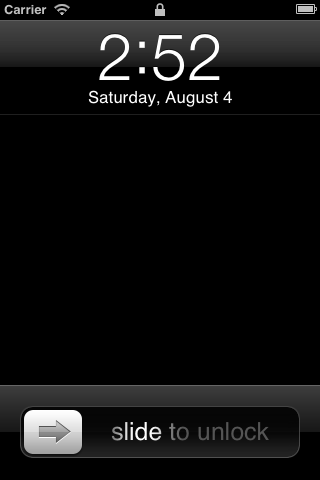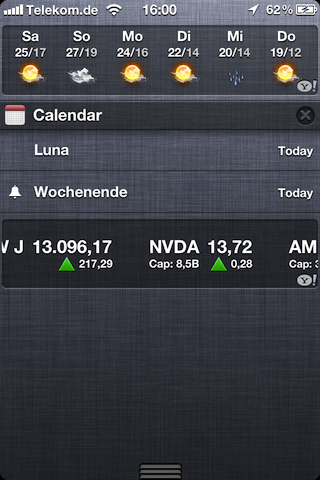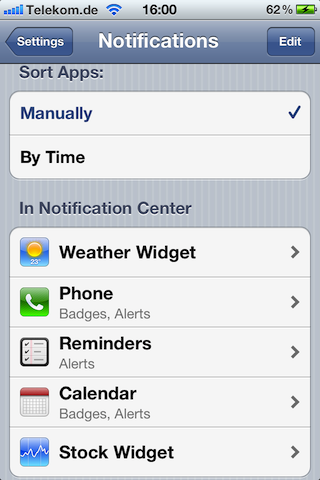In this article, I merely speculate based on publicly available information. Because it’s fun to speculate :)
We know pretty well by now how the next iPhone is going to look like, and Apple advertizes the upcoming iOS 6 update. What’s coming?
Hardware:
- new design with bigger screen
- new connector, headphone jack at the bottom, Nano-SIM
- likely 4G LTE connectivity
- perhaps NFC
- much more powerful battery (I’ll explain that guess below)
Software (iOS 6):
- new Maps
- improved Siri
- Facebook integration
- lots of new features for core apps
- Feature X
Exhibit 1: Features That Only Work on the Latest Hardware
What’s Feature X? I’m not talking about One More Thing. It’s the feature that will not be available on the iPhone 4S and older. Let’s look back at the history of the last iPhones, where each had a killer software feature to justify the new hardware:
- Original iPhone: Safari, widescreen iPod
- iPhone 3G: GPS → location services (iPhoneOS 2.0)
- iPhone 3GS: better camera → Tap to focus, video recording (iPhoneOS 3.0)
- iPhone 4: A4 chip and more RAM → Multitasking (iOS 4)
- iphone 4S: faster, dual core CPU, noise cancellation chip → Siri (iOS 5)
All these features are software features of the core OS, but they were only available on the latest hardware. The limitation seem deliberate: Just a way to sell more devices.
But each time, it turned out there are specific technical reasons to exclude the new features from earlier hardware, as shown by attempts to use Siri on iPhone 4’s (lack of earSmart and Infrared proximity sensor), having background images on the 3GS (CPU too slow, so scrolling on homescreen stutters), or using multitasking on an iPhone 3G (too little RAM to keep more than one app).
You can of course argue that Apple should rather have enabled features on older iPhones to make customers happy. But I think quite the opposite would happen. iPhoneHacks summarized it this way:
Apple is in a no-win situation on this one. iPhone 3G users are unhappy that one of the major features in iPhone OS 4.0 is not available to them but if it had enabled this feature for iPhone 3G, Apple would get criticized and receive complaints for the sluggish performance.
For Apple, that’s not even a question: Of course they will choose perfect execution over legacy support. With their strong brand, they seem to be able to turn this into a win situation again and again.
And of course it’s a way to sell more new devices! That’s exactly what this is about — making awesome products and sell them at high margins. That is Apple’s business model. They need killer features on each new device, and they have years of experience (since the iPod) how to do that on a yearly basis.
For these reasons, I think Apple will reveal another unknown iOS 6 feature that will only run on the new iPhone. To exclude it from earlier iPhone generations will seem like a deliberate decision, until people backport it and confirm that it’s also Apple’s insistence on the best possible experience.
Exhibit 2: Finally! — Notably Missing Features
Copy & Paste, Multitasking, Notification Center, folders, a front-facing camera – if there is something obvious missing from Apple’s software or hardware, there’s a very good chance that it’s only a matter of time until it arrives. Sometimes, it takes years. Apple has been claiming that they “wanted to get it right”, and I believe that’s true, but not the whole story. Sometimes, they have to wait for the hardware to get better (see Exhibit 1).
And sometimes, they hold back on certain features to schedule them strategically for a well-balanced next release: Releasing enough to make lots of people want the upgrade, but still keeping enough in the pipeline to ensure a great next release — even if some planned features can’t make the deadline. It’s just good planning when you have an annual release schedule. Watch the past keynotes to hear people cheer and applaud whenever such a missing feature was finally announced — that’s the reward for good strategy, and the recipe to fulfill high expectations.
There is one basic feature that has been missed, rumored, begged for since the first iPhone: Widgets. I’m talking about automatically updated panels of information, always available on the lock screen. Weather, calendar, stocks, news, social stream, mails, maps, you name it. It’s clear that some day, Apple will add widgets to iOS.
It seems to be a simple feature, phones have had them for years. Even primitive feature phones from the ‘90s could show a calendar on the lock screen. Android has them (on the home screen and on the lock screen, too). Windows Phone 7 is build around it (Live Tiles). So, why hasn’t Apple released this feature yet?
Several possible reasons:
- They have not found an interface solution that’s seamless, easy to understand, and fun to use.
- They hold it back for strategic reasons.
- It requires hardware that is not available on older models.
All of these are likely. The last one is the interesting one.
More Space
Let’s go back to the all-but-confirmed new hardware features of the iPhone 5: A bigger screen, 4" instead of 3.5"! What if the widget interface Apple plans to introduce makes very good use of those additional 0.54" (1.37cm) of height?
Take a look at the current iPhone lock screen. Right now, there’s only one “widget”, the clock (including the current date). When I double-click the home button, I get a combined clock/iPod control widget:


There is some room left for widgets below these (without scrolling). Let’s assume iOS widgets are full-width:
- Apple doesn’t want to copy the tile look from Microsoft.
- Wide widgets look nicer and can contain text.
- The Notification Center already features two such full-width widgets, Weather and Stocks:


They are even called “Widgets”. You can turn them on and off, and move them around in the Settings (not a very intuitive interface in my eyes).
That’s why I think this would be the most likely style for widgets on the lock screen. Enough room to display more than just a number (a problem with half-width tiles), but narrow enough to fit of few of them on the same screen.
The top widget would always be the clock one — it’s just the most important thing on the lock screen. I guess Apple wouldn’t even let you turn it off.
So, how much room for more widgets do we have left?
- Total height: 480 points1 (current iPhones)
- Status Bar: 20 points
- (optional) In-Call Status Bar: 20 points
- Clock widget: 95 points (and up to about 190 points with iPod controls)
- Unlock slider / camera button: 95 points
- 480 – 20 – 20 – 95 – 95 = 250 points left for widgets
Let’s assume that a widget slot will also be 95 points high, the same height as the clock (without iPod controls) and the unlock slider. The remaining 250 points on current iPhones leave us with room for only 2.63 widgets slots. However, on the new 4" screen, we have 88 more points, which gives us room for about 3.56 widgets. Apple can comfortable fit 3 user widgets on the lock screen on the iPhone 5, but only 2 on all previous versions.
Of course, widgets are useful even if you can put only two of them on the lock screen — but it’s much nicer to have three:
- social widget (I would choose Twitter.)
- weather widget (I’m using the one in the notification center a lot.)
- news widget, depending on your interest (stocks, sports, iPhone rumors, …)
All these and the clock without the need to scroll — awesome.
It’s not the strongest argument for iPhone-5-only widgets, but a possible one.
More Power
Widgets don’t come for free. They need to pull new data in the background (a Twitter widget, for example, should update at least every minute) because they need to be up to date when you look at them. They need to be rendered whenever you click the home button, even if they just wanted to check the time (which happens a lot in my experience). And if the new widgets are so great and helpful, you will want to use them a lot — which means the home button will be pressed even more often.
What’s more, widgets need RAM — to store the views and their data, to keep them active as mini-apps. They are running all the time, in addition to the OS and all your running apps. Maybe the 512 MB on the iPhone 4 and 4S would be enough, but maybe you need more, and Apple will update the iPhone 5 to 1GB of RAM (also to deal with the additional pixels on the screen).
Guess what? More RAM needs more power.
So, we need additional battery power for widgets. I say the iPhone 5 will provide it, based on the example of the new iPad: It includes an updated battery in which Apple stuffed 42.5 Wh into almost the same space as the previous 25 Wh battery – that’s 60-70% more battery life! Imagine such a battery on the iPhone, which has just 5.3 Wh currently. How much could the new iPhone have?
A slightly bigger, but slightly thinner iPhone also has about the same volume. The battery won’t get any bigger overall. But if it uses the new iPad’s battery technology, you get way more power out of it, 8 or 9 Wh perhaps.
The screen is bigger (18% more pixels), but if it’s really IGZO, it should use less power than the old display. Of course, 4G will draw a lot more power than 3G, but I’m sure Apple uses the most efficient chipset they can find, and frankly, there are more interesting things you can to with an improved battery than support shiny new cellular networks with spotty coverage. Like widgets.
If the new iPhone has enough battery power to add new features on top of 4G, Apple will use it. The current iPhones probably don’t have enough to support lock screen widgets without reducing battery life. That, for me, is the strongest argument why we might not see widgets on older iPhones.
How Can Apple Spin This?
If Apple announces this long-awaited feature as an iPhone-5-only trick, people will go to the barricades. They better come up with a good story explanation to convince people (or at least some tech writers) that there is a technical reason behind this decision, and it’s not just for boosting sales.
The More Space argument doesn’t help here. People have yearned for widgets since when the original iPhone, when its 3.5" screen was considered big. Even if Apple says widgets just need the additional space on the new iPhone, most people won’t agree.
So, the More Power argument better needs to be convincing. If you present Lock Screen Widgets as the third major feature of the new iPhone (right after new design with bigger display and 4G), it might seem logical. This could be Phil Schiller, September 12th 2012:
Here’s the New iPhone. It’s the most beautiful handset ever created, even thinner than the iPhone 4S. It has unbelievably fast 4G LTE speed. And yet, it gives you even more talk time and time to use your favorite apps on a single charge, thanks to our revolutionary new battery technology. It also enables another power-hungry feature without reducing your battery life: Lock. Screen. Widgets.
*roaring applause*
They would show how cool widgets are, how they are far more useful and beautiful on the iPhone 5 than on any other device out there, that the interface to configure them is incredibly easy to use. Maybe they even allow third-party Apps to have/be widgets, but I doubt it (again, think strategy).
My Prediction
Apple will generate the usual I-Want-It reaction with the Lock Screen Widgets demo. AAPL will dive, because the stock market is crazy.
After the event, journalists will realize that older iPhones won’t get the awesome new Widgets. They will start a shit storm. Android advocates will laugh at Apple for being late to the party, for copying Android, for not being open, and for being Apple. John Gruber will write a short, calm article explaining Apple’s reasons. Jim Dalrymple will do the same, but with more curse words. The Macalope will write a hilarious column.
Haters will be haters, and the iPhone 5 will sell like hotcakes. Because people love widgets, and because the hardware is up to it.
1 I’m using the “points” metric here, where 1 point = 2 pixels on Retina displays.